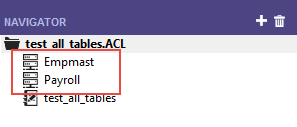
Use server tables to store confidential data on AX Server that you can audit from ACL Analytics without downloading sensitive data to your local file system. Keeping the data on AX Server ensures the security of the data while providing audit access to authorized ACL Analytics users.
To complete this quick start, you need the following:
Note
By default, the sample data projects are installed at C:\Users\username\Documents\ACL Data on your local file system.
Start by creating a destination collection and folder in the Library of AX Server. A collection is a high level container for project folders in Analytics Exchange:
Tip
We will create this collection in the Library so that only Administrative users can directly access the data associated with the project. Non-administrative users can access the data indirectly via linked tables and server tables. For more information, see Accessing data through tables.
Name the collection something meaningful so that your projects and audit content are easily found in AX Server.
This folder is the target for your project import, so use a name that identifies the source ACL project.
Next, import the project from ACL Analytics into the folder you created in the Library on AX Server:
Result the project is imported to the target folder and appears in the Analysis Apps sub-folder. The project's tables appear in the Data sub-folder.
Create a collection and folder in the Working directory for non-administrative users to access the secure data via linked tables. This indirect access keeps confidential data safe from unauthorized access and unintentional change:
Name the collection something meaningful so that your projects and audit content are easily found in AX Server.
This folder is the target for your project import, so use a name that identifies the source ACL project.
Tip
Use application permissions to control which users have access to this folder. You can limit access to only those individuals assigned to work with the folder data. For more information, see Application permissions.
Result the tables are pasted as linked tables and appear in the Data sub-folder in the Working directory. For more information about linked tables, see Linked tables.
Now that you have setup the linked tables in AX Client, you can export the Working directory folder as an ACL project containing server tables. Server table data files remain on AX Server while the table layout used to read the data is exported with the project.
Authorized users can access this secure data remotely from ACL Analytics using the server profile:
Note
Clearing this check box instructs AX Server to exclude the underlying source .FIL data files from the export. When you open the exported project in ACL Analytics, the tables in the project connect to AX Server securely using your server credentials and read the data from the protected source files.
Result the folder is exported as an ACL project called folderName_all_tables.ACL and the project opens in ACL Analytics. The icons next to the table names confirm that the tables were exported as server tables:

In ACL Analytics, enter your Analytics Exchange credentials in the Server Profiles dialog box so that you can connect to AX Server to work with the confidential data securely stored on AX Server:
| Setting | Description |
|---|---|
| Profile Name | The name of the server profile: Analytics Exchange |
| User ID | Your AX Client user ID |
| Password | Your AX Client password |
| Prefix | The file path of your working directory on AX Server: c:\acl\data\aclse\\userName |
| Host Name | The host name of the AX Server instance you are connecting to |
| Port | The port used to connect to AX Server: 10000 |
Result you can now work with the server tables in the project. When you open a table, ACL Analytics opens a read-only connection to the data on AX Server and you can analyze the tables without ever downloading the confidential data to your local file system.